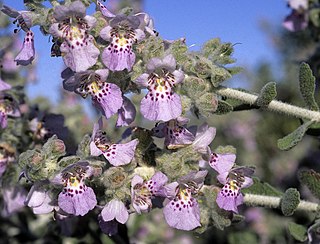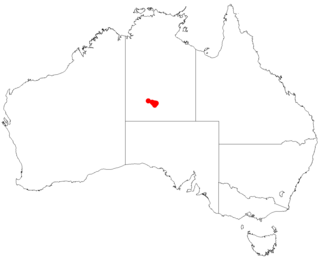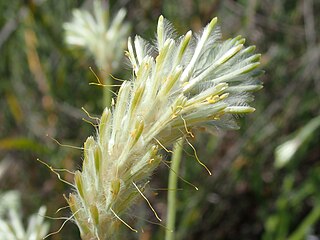
Charles Gaudichaud-Beaupré was a French botanist.

Pityrodia is a genus of flowering plants in the mint family, Lamiaceae and is endemic to Australia, most species occurring in Western Australia, a few in the Northern Territory and one in Queensland. Plants in this genus are shrubs with five petals joined to form a tube-shaped flower with four stamens of unequal lengths.

Dasymalla is a genus of five species of flowering plants in the mint family, Lamiaceae and is endemic to Western Australia. Plants in this genus are woolly shrubs with five petals joined to form a tube-shaped flower with four stamens of unequal lengths. These species are similar to those in the genus Pityrodia except that the fruit does not release its seeds when mature.

Hemiphora is a genus of five species of flowering plants in the mint family, Lamiaceae and is endemic to Western Australia. Plants in this genus are woolly shrubs with warty, hairy leaves and with five petals joined to form a tube-shaped flower with four stamens. These species are similar to those in the genus Chloanthes in that the base of the leaves extends down the stem. They differ from Chloanthes, in that the leaves only extend a short distance down the stem.

Prostanthera prostantheroides is a plant in the family Lamiaceae and is endemic to Western Australia. It is a shrub with heart-shaped to round leaves and usually white flowers with purple spots inside the petal tube.

Muniria is a genus of four species of flowering plants in the mint family, Lamiaceae and is endemic to the Northern Territory in Australia. Plants in this genus are woolly shrubs with five petals joined to form a tube-shaped flower with four stamens of unequal lengths. These species are similar to those in the genus Pityrodia except that the branches are distinctly 4-angled in cross section and the fruit has calluses or ridges.

Quoya atriplicina, commonly known as saltbush foxglove, is a flowering plant in the mint family Lamiaceae and is endemic to Western Australia. It is a bushy shrub with its branches and leaves densely covered with a layer of hairs, giving them a greyish appearance. The leaves are broad-elliptic to almost circular in shape and the tube-shaped flowers are pink with purple spots inside.

Quoya oldfieldii, commonly known as Oldfield's foxglove, is a flowering plant in the mint family Lamiaceae and is endemic to the south-west of Western Australia. It is an erect shrub with its branches and leaves densely covered with a layer of brownish hairs. The leaves are egg-shaped and the tube-shaped flowers are pink with purple spots inside.

Quoya cuneata is a flowering plant in the mint family Lamiaceae and is endemic to the south-west of Western Australia. It is a spreading shrub with its branches and leaves covered with a layer of woolly, pale white or brownish hairs. The flowers are blue at first but become white with purple spots inside the petal tube.

Quoya dilatata is a flowering plant in the mint family Lamiaceae and is endemic to Western Australia. It is a low, spreading shrub with its branches and leaves densely covered with a layer of white, woolly hairs. The leaves are wrinkled or crinkly and the tube-shaped flowers are orange-red and hairy on the outside.

Quoya loxocarpa is a flowering plant in the mint family Lamiaceae and is endemic to Western Australia and the Northern Territory. It is an open shrub with many spindly tangled branches. The leaves are oblong and woolly when young and the flowers are whitish pink with purple spots inside and are surrounded by woolly sepals.

Ptilotus obovatus(Gaudich.) F.Muell. is a shrub in the genus Ptilotus R.Br. that occurs in throughout arid Australia. It is commonly known as cotton bush.
Quoya paniculata is a flowering plant in the mint family Lamiaceae and is endemic to Western Australia. It is a shrub with its branches and leaves densely covered with a layer of woolly hairs. The flowers are usually arranged in small groups surrounded by woolly hairs and are bell-shaped and deep purple or deep lilac. It is similar to Dasymalla axillaris and D. terminalis but is distinguished from them by its wedge-shaped leaf ends and more northerly distribution.

Quoya verbascina, commonly known as golden bush, is a flowering plant in the mint family Lamiaceae and is endemic to Western Australia. It is an erect shrub with its branches and leaves densely covered with woolly hairs. The leaves are often oblong but very variable in shape and the flowers are pinkish-white with pink spots inside and are surrounded by yellow woolly sepals.

Dendrobium mirbelianum, commonly known as the dark-stemmed antler orchid or mangrove orchid, is an epiphytic or lithophytic orchid in the family Orchidaceae. It has cylindrical, dark-coloured pseudobulbs with leathery, dark green leaves and up to twelve pale to dark brown flowers with a yellow labellum with dark red veins. This antler orchid occurs in northern Australia, New Guinea and Indonesia.

Scaevola chamissoniana is a shrub in the family Goodeniaceae and its native range is the Hawaiian Islands, where it is known as the Mountain naupaka or Naupaka kuahiwi.

Prostanthera schultzii is a species of flowering plant in the family Lamiaceae and is endemic to the Northern Territory. It is a shrub with heart-shaped to round or paddle-shaped leaves and white flowers with purple spots and yellow patches on the lower lip.

Ptilotus polystachyus is a grass-like plant in the Amaranthaceae family.

Ptilotus divaricatus is a grass-like plant in the Amaranthaceae family.

Goodenia berardiana is a species of flowering plant in the family Goodeniaceae and is endemic to Australia. It is an erect, widely distributed and variable annual herb with linear to egg-shaped, sometimes lobed or toothed leaves, and yellow flowers arranged in leafy racemes or few-flowered umbels.



















